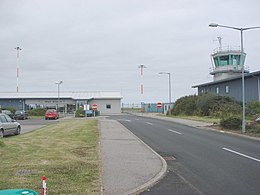Wick Airport: Difference between revisions
Created page with "{{Infobox airport |name=Wick Airport |county=Caithness |town=Wick |picture=Wick Airport.jpg |picture caption=Wick Airport terminal |IATA=WIC |ICAO=EGPC |os grid ref=ND362526..." |
No edit summary |
||
| Line 8: | Line 8: | ||
|ICAO=EGPC | |ICAO=EGPC | ||
|os grid ref=ND362526 | |os grid ref=ND362526 | ||
|latitude=58 | |latitude=58.456987 | ||
|longitude= | |longitude=-3.095025 | ||
|runway length={{convert|1,825|m|ft|0|x}} | |runway length={{convert|1,825|m|ft|0|x}} | ||
|owner=Highlands and Islands Airports Limited | |owner=Highlands and Islands Airports Limited | ||
Latest revision as of 14:26, 17 June 2017
| Wick Airport | |
 | |
|---|---|
| Code | IATA: WIC, ICAO: EGPC |
| County | Caithness |
| Owner | Highlands and Islands Airports Limited |
| Location | ND362526 58°27’25"N, 3°5’42"W |
| Runway | 5,988 feet |
| Website | Wick Airport |
Wick Airport (IATA: WIC, ICAO: EGPC) is a private airport in Caithness, one nautical mile north of the burgh of Wick. It is owned and maintained by Highlands and Islands Airports Limited.
The airport provides air travel connections for Caithness, with scheduled services to Aberdeen Airport and Edinburgh Airport. It is also regularly used by helicopters servicing local offshore oil operations, and as a stop-over by light aircraft ferry flights between Europe and North America via Iceland.
The airport is marketed as Wick John O' Groats by FlyBe, which operates a daily service (excluding Saturdays) to Edinburgh, using its franchise partner Loganair.
History
Wick was originally a grass airfield, used by Captain E. E. Fresson's Highland Airways Ltd. (later Scottish Airways Ltd.) from 1933 until 1939.
RAF Wick
Requisitioned by the Air Ministry during Second World War, the airfield was extended with hard runways, hangars, and other buildings. The airfield was administered by No. 18 Group, RAF Coastal Command. A satellite airfield existed at RAF Skitten.
On 21 May 1941, a photographic reconnaissance Supermarine Spitfire piloted by Flying Officer Michael F. Suckling took off from Wick, and flew to Norway, in search of the German battleship Bismarck. If Bismarck were to break out into the North Atlantic, she would present a significant risk to the ships supplying Britain. 320 miles to the east of Wick, F/O Suckling found and photographed her, hiding in Grimstadfjord.[1] This information enabled the Royal Navy to order HMS Hood and other ships, as well as aircraft, to take positions intended to track Bismarck, and prevent her from entering the North Atlantic. In ensuing battles, Hood was sunk, and, later, Bismarck. German battleships and battle cruisers never again entered the North Atlantic.
Outside links
| ("Wikimedia Commons" has material about Wick Airport) |
References
- ↑ Conyers, Roy (2003). Eyes of the RAF. Sutton Publishing. pp. 118. ISBN 0750932562.
- Halley, James J. The Squadrons of the Royal Air Force. Tonbridge, Kent: Air-Britain (Historians) Ltd, 1980. ISBN 0-85130-083-9
